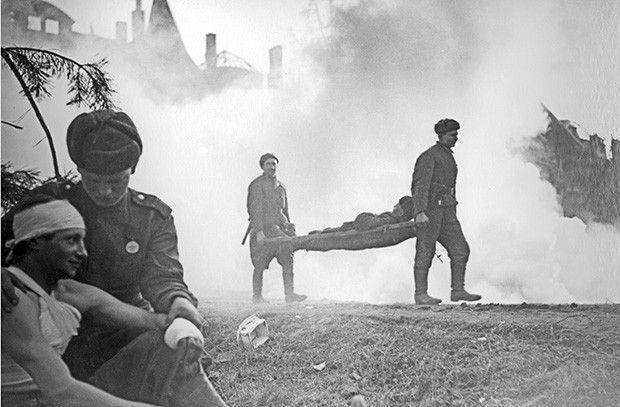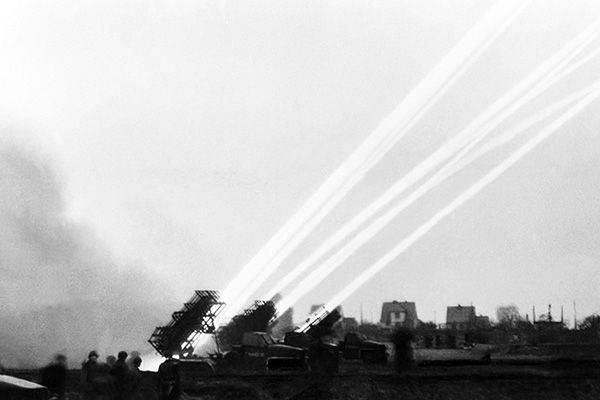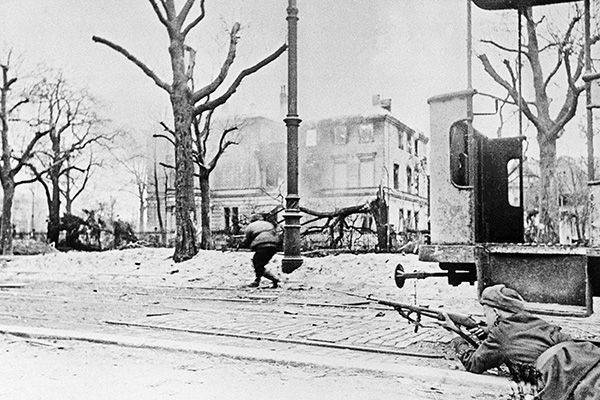How did the last German support fall

6 May 1945 of the Year capitulated to Breslau
The thousands garrison of Breslau, the capital of the German Silesia, surrendered to the Soviet winner after a three-month assault from January to May 1945. It was the longest and stubborn siege of the German city, declared by Festung by Hitler, that is, a fortress. With an equal number of Germans who defended the fortifications and stormed the Soviet troops, both the fascists and our soldiers used a large number of the most modern weapons and many of the most cunning military techniques.
"The Fuhrer will order me to shoot ..."
For a thousand years, the area of Breslau (now Polish Wroclaw) was the border of the German and Slavic worlds. It is no coincidence that in the 30-s, after coming to power, Hitler became concerned with the renaming of the last Slavic names in the area of Breslau. At that time, this 600-thousand city was the capital of the “Silesian Industrial District”, one of the most important industrial centers of Germany.
The whole area was an almost continuous urban development, 70 km wide and over 100 km long. This area was completely built up with reinforced concrete industry facilities and residential houses of massive masonry. Both in our time and in the years of the Second World War, precisely such territories are the most convenient for defense and the most difficult in the attack.
By the beginning of 1945, major cities on the eastern border of the Reich, including Breslau, were declared by Hitler "festungs" - fortresses. They were intensively prepared for defense. Karl Hanke was appointed the head of defense of the “Breslau Fortress”. The fanatical Nazi was not a military professional, but had previously worked as personal secretary to the Reich Minister of Propaganda Joseph Goebbels.
By 1945, nearly half a million German refugees from Polish territories had accumulated in Breslau. When the military offered Karl Hanke to begin an early evacuation of the civilian population from the “Breslau fortress”, the Nazi refused with the words: “The Fuhrer will order me to be shot if I come to him with such proposals now.”
By January 19, our advance units crossed the German border. As General Guderian later recalled, the Wehrmacht’s chief of staff then said: “Finally, Hitler made the decision to go over to the Western front to defend and to release the liberated forces to the East. I made a plan to use the reserves, intending to transfer them immediately to the Oder ... "
The “Breslau Fortress” just covered the bridges over the Oder, the last major water barrier on the way to Berlin. The 303 bridge over the Oder and its tributaries was located here.
22 January 1945, the advanced units of the 1 of the Ukrainian Front reached Oder north of Breslau. The first five fighters, who crossed the river Oder, were awarded the title Hero of the Soviet Union. Three Soviet armies and a guard cavalry corps began to surround the Silesian industrial region from the north and south.
The rapid breakthrough of the Soviet troops came as a complete surprise to Hitler, in a rage he began to frantically change the generals in command posts. At the end of January 1945, the Gauleiter Hanke issued an order to evacuate civilians from the “Breslau Fortress” on foot. Tens of thousands of women, old people and children moved from the capital of Silesia to the east. Nobody prepared routes, accommodation and meals for refugees. It was on these days that Germany was in severe frosts. The account frozen on the roadsides to the east of Breslau went to many thousands, if not tens of thousands. Some of the refugees who left on foot eventually even returned to Breslau. It turned out that the panic evacuation announced by gauleiter Hanke and causing many deaths was premature - the Soviet troops closed the encirclement around Breslau only two weeks later. The gauleiter Hanke decided to disguise his failure with hysterical terror - on his order 29 January 1945 in the center of Breslau in front of the monument to King Frederick II was shot by the city burgomaster Spielhagen. The former secretary of Goebbels accused him of intending to leave Breslau without an order. “Those who fear honest death will die in disgrace!” Said Gauleiter Hanke’s appeals on the streets of Breslau, which in three months he would run away from the city on the eve of his fall ...
"Flying torpedoes"
The Soviet ring of encirclement around Breslau finally closed at 10 in the morning hours of February 13 of the year 1945. The main forces of the 1 of the Ukrainian Front operating in Silesia were engaged in an offensive in the direction of Berlin, so for the assault on the surrounded Breslau they allocated only one 6 Army commanded by Lieutenant-General Vladimir Gluzdovsky.
According to the Wehrmacht’s General Staff, the February 1945 garrison numbered about 50 thousand troops (according to other estimates, in the confusion of the German retreat in Breslau, along with various rear units, it was surrounded by up to 80 thousand Thousand-Wehrmacht and SS soldiers - Note). and over 80 thousand civilians mobilized for the defense of the city. All local policemen, “Hitler Youth” detachments and even firemen were involved in the defense.
The 6th Soviet Army, which was besieging Breslau, had only six rifle divisions with attached artillery, but initially without large tank parts. In total, this is over 80 thousand fighters, but in reality the number of advancing Soviet divisions was smaller. As a result, no more than 60 thousand of our soldiers stormed Breslau, that is, our troops did not have any quantitative superiority over the enemy.

The defense was promoted by many water barriers in the form of channels and tributaries of the Oder River, as well as solid stone buildings, which were reinforced by numerous barricades, anti-tank ditches and pre-prepared defense units. During the assault, which lasted three months, from February to May 1945, the most recent and perfect weapon at that time was used on both sides. To support the advancing infantry 6 of the Soviet army, to break through the stone building of Breslau, heavy self-propelled and tank regiments (1945 tanks EC-13 and 2 self-propelled guns ICU-8), as well as six 152-mm mortar BMRs arrived in February 280 -5, shooting concrete-projectiles with a weight of 246 kg.
For the assault on Breslau, a separate engineering-sapper brigade arrived, the fighters of which were equipped with trophy "faust-cartridges", flamethrowers and steel shells (prototypes of body armor). It was these fighters who used the so-called “flying torpedoes” in Breslau.
It was the original front-line invention of Russian soldiers, when around the corps of a conventional rocket from the Katyusha a wooden barrel of streamlined shape was fastened with iron hoops, into which they poured up to 100 kilograms of tola. For stability in flight, wooden stabilizers were attached to the tail of the “flying torpedo”. Shooting was carried out from a wooden box with iron runners as guides. Such a “torpedo” flew at a distance of up to a kilometer, in the ground its explosion made a crater in 3 meters deep, and when it hit the stone structure, it demolished it completely.
"Damned Germans are fighting as doomed ..."
The Germans also used a lot of combat tricks. Because of the fighting, the streets of the city were covered with broken bricks, and the Nazi soldiers came up with the idea of disguising anti-personnel mines as fragments of bricks. To do this, wooden hulls of anti-personnel mines were covered with linseed, and then sprinkled with red brick dust, so that they could not be distinguished externally from bricks.
At night, such “brick” mines were installed with the help of fishing rods from the windows of surviving houses, basement hatches or from ruins. This made it possible to create new minefields even when opponents were literally just meters apart during the battles in city houses: often one part of the building was controlled by Soviet and other German soldiers.
In response, the Soviet soldiers used a lot of their combat tricks from improvised means. For example, in order to quickly pierce passages in the stone walls of houses, our sappers mastered directional explosions, using water hatches as reflectors of a blast wave.
The first battles for the capture of the city began in the southern part of Breslau 22 February 1945 of the year. But only after a month of stubborn fighting, literally for every house, Soviet troops managed to occupy all the outskirts of Breslau, pushing the Germans back to the central part of the city.
Lieutenant of a separate flame-throwing company, Vladimir Belik, kept his diaries of the siege of Breslau. An entry on March 5 of 1945 shows: “Just a few days in Breslau, but they seem like an eternity. In these few days I lost before the 20 people from the existing 70 ... Damned Germans fight like doomed - the military, civilians, men and women fight. Fighting for every house, floor, room ... "
Soviet intelligence even used a psychological special operation against the garrison of the city. One spring day in the wake of Radio Germany, right after the morning release News our special services managed to break into German broadcasting and allegedly transmit information on behalf of German radio that the tank divisions of the Wehrmacht broke through the encirclement of Breslau. The calculation was based on the fact that the garrison and the population of the city, after the inevitable euphoria of such misinformation, faced with a harsh reality in which there was no breakthrough in the environment, could not stand it and psychologically break down.
Indeed, it was then in the city, realizing that the long-awaited salvation did not come, the first remarks were heard about the futility of resistance. But Gauleiter Hanke, relying on the Gestapo, managed to crush these sentiments, immediately shooting for any statements in favor of surrender. The siege of Breslau dragged on for another month.
Sisyphean labor was in vain
1 April 1945, our troops were able to capture the last airfield, which connected the surrounded Germans with the center of Germany. To preserve the psychological readiness of the troops and the population of Breslau to resist, the gauleiter Hanke ordered to build a new airfield right in the center of the city.

The command of the "Wehrmacht" objected, pointing to the senselessness of this idea. But the fanatical gauleiter mobilized many thousands of citizens to build an airfield along the Kaiserstrasse, the main street of Breslau. To this end, for one and a half kilometers, buildings were blown up on both sides of the street and began to clear mountains of broken brick and rubble. Sisyphean labor was in vain, the airfield could not take cargo planes.
In April, the Soviet troops no longer stormed Breslau in April, but kept the city under siege; after the seizure of the airfield, they fought only in separate blocks from 1945 to 6 in April and from 12 to 25 in April. April 30 "fortress" Breslau learned about the suicide of Hitler, May 30 - about the surrender of Berlin. This was reported to the city by loudspeakers placed on the positions of the Soviet troops.
On May 4, a delegation of the Catholic and Protestant priests of the city appealed to the command of the German garrison; they spoke of the futility of further resistance and asked for surrender. In response, Gauleiter Hanke issued a new order, in which it was forbidden for residents to, under the penalty of being shot, even utter the word “surrender”.
But after that, the Führer Breslau did not show the citizens an example of a heroic death, but banally escaped. After informing the military command that he was allegedly appointed as the successor of Himmler at the head of the SS, Hanke got on the last light aircraft in the city and flew out of the city forever.
The next day, May 5, the German positions reached the Soviet positions with a request for surrender. After negotiations on the way back, one of the members of the German delegation blew up on a German mine, the one skillfully disguised as a piece of brick.
On Sunday, 6 in May, 1945 of the year resisting 80 for days, surrounded by “Breslau Fortress” completely capitulated. During the siege and street battles, our troops lost thousands of people killed over 5. The enemy’s losses amounted to 6 thousand dead and over 23 thousand thousand wounded. Almost 40 thousand German soldiers and officers surrendered.
7 May 1945, in Moscow by a special order of the Supreme Commander in honor of the troops participating in the battles for the capture of Breslau, was given a solemn artillery salute.
Information